[Profile] Xiong Guangze, male, born in 1938, from Danling, Meishan, Sichuan. Professor, doctoral supervisor, and expert enjoying special government allowances from the State Council. Graduated in 1962 from Chengdu University of Electronic Science and Technology with a degree in Computer Science, he stayed at the school to engage in teaching and research in computer science. He served as the deputy director of the Microcomputer Research Institute of the University of Electronic Science and Technology, director of the Embedded Real-Time Systems Research Laboratory, and deputy director of the UN project Microcomputer Application Development Training Center, and held academic positions such as executive director of the Sichuan Computer Society and the Sichuan Microcontroller Application Association. He received UN scholarships twice, studying microprocessor application development technology at IMAG in Silicon Valley, USA from 1982 to 1983, and real-time software technology at the CIT Polytechnic University in Melbourne, Australia from 1986 to 1987. After returning to China, based on his overseas study expertise, he established the Embedded Real-Time Systems Research Laboratory, undertaking multiple national science and technology projects during the “Eighth Five-Year Plan,” “Ninth Five-Year Plan,” and “Tenth Five-Year Plan,” achieving a series of embedded real-time software results, including the EMUL series of online emulators, airborne embedded real-time operating systems, 32-bit strong real-time embedded operating systems, microkernel embedded operating systems, and real-time software reliability testing systems, which have been put into production and defense applications. He has trained over 70 master’s students, 13 doctoral students, and 3 postdoctoral researchers for the country.
The sunlight from the Second Hospital of the East gently falls on Professor Xiong Guangze’s face through the glass window. He skillfully takes out a cup from the 55th anniversary celebration and places it on the table. The steaming heat and the soft chirping of cicadas blend with Professor Xiong’s rhythmic speech, and the occasional switch between Chinese and English makes our thoughts even more lively as he shares his story on this early autumn day.
In 1938, Xiong Guangze was born in Danling, Sichuan. Danling is a small ancient city that has produced some famous figures, such as Li Tao, and Su Dongpo from Meishan is also close to Danling. Their thoughts subtly influenced every child living here, including Xiong Guangze. In 1952, at the age of 13, Xiong Guangze joined the New Democratic Youth League. In 1956, while studying at Hongya High School, he became one of the first batch of party members as the country began to develop party members in high schools. Joining the league and the party has been a significant part of his life, laying the foundation for his worldview and values. He resolved to dedicate his life to the party, the country, and the people.
Entering Chengdu University of Electronic Science and Technology was a serendipitous coincidence for Xiong Guangze. During high school, Soviet films were very popular, and the scenes of “upstairs and downstairs, electric lights and telephones” and “Soviet + electrification” repeatedly appeared in his mind, leading him to aspire to “master electrification and build a new China.” Due to his intelligence, learning was very easy for him; he not only excelled academically but also frequently participated in speech contests and amateur Sichuan opera performances. He remembers participating in a speech contest with the topic “Mastering Electrification, Building a New China,” and winning first prize, which made him feel elated for many days. In 1957, when he took the college entrance examination, he happened to meet a senior who was back home to promote enrollment. This was the first time Xiong Guangze heard the name Chengdu University of Electronic Science and Technology. The senior’s personal testimony piqued his curiosity and longing for Chengdu University of Electronic Science and Technology, which was also close to his hometown and had majors related to electricity. Thus, he decided to apply for the university’s Radio Department, and from then on, Xiong Guangze’s fate was tightly linked to Chengdu University of Electronic Science and Technology.
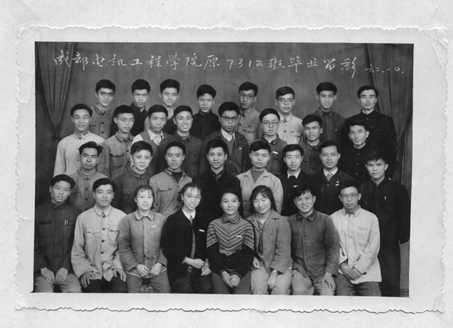
Graduation photo of Class 7312 from Chengdu University of Electronic Science and Technology
During his time at Chengdu University of Electronic Science and Technology, three teachers left a deep impression on Xiong Guangze. Professor Zhou Xiling from Wuhan University started researching operating systems early and was proficient in both hardware and software. He was Xiong Guangze’s enlightening mentor in operating systems. Professor Zhou believed that having computer hardware alone was not enough; software was also necessary, and the soul of software was the operating system. Although he had never been abroad, Professor Zhou continuously collected materials and books on foreign operating systems, even translating hundreds of thousands of words on operating systems while working in a labor camp. These materials were sent to relevant departments in Beijing for printing and publication, making a significant contribution to China’s research on operating systems. Another mentor was Professor Liu Jinde from Jiaotong University, who was Xiong Guangze’s enlightening mentor in analog computers and also his guide in research. They worked together during difficult times to achieve multiple results. Another was Teacher Jiang Mingde, who had studied software and algorithms at the Soviet Academy of Sciences and had a significant impact on Xiong Guangze’s growth.
Chengdu University of Electronic Science and Technology brought together the strengths of several universities, creating an excellent platform for researching computers. Xiong Guangze felt very fortunate and benefited greatly from studying here, laying the foundation for his involvement in research on operating systems, microcomputers, and embedded systems.
“The times create heroes.” When mentioning his experiences abroad, Xiong Guangze is filled with gratitude for the international situation and opportunities at the time. As a developing country, China was precisely the target that the United Nations needed to support. As part of the United Nations Industrial Development Organization (UNIDO), its mission is to “help developing countries improve their level of industrialization and coordinate the activities of the United Nations system in industrial development.” Based on this mission, aid projects for China were established. Seizing this development opportunity at the beginning of the reform and opening-up period and actively improving the school’s conditions was crucial for its development. With the school’s efforts and strong support from the Ministry of Electronics Industry, our university successfully obtained a total of $700,000 in UNIDO aid, establishing the UNIDO Microcomputer Application Technology Development Training Center at Chengdu University of Electronic Science and Technology. The Ministry of Electronics Industry also approved the establishment of the Microcomputer Research Institute at our university, creating a dual-entity institute to conduct research on microcomputer technology.
In the 1980s, China faced developmental bottlenecks and encountered cold shoulders from other countries; we experienced unfair treatment and faced historical challenges, but we never considered retreating. To seize this opportunity, Xiong Guangze bravely made changes, stepping out of his comfort zone, shifting from analog computers to digital computers, and was sent to Silicon Valley, USA, to explore and learn cutting-edge technology, becoming the first Chinese to study in Silicon Valley. Silicon Valley was the kingdom of the electronic and computer industries in the USA, and there were inevitably many obstacles to delve into it. UNIDO, headquartered in Geneva, found a German philanthropic chemical foundation to act as a responder, arranging for Xiong Guangze to enter Silicon Valley and begin his study abroad experience for over a year.
Opportunities are hard to come by, and Xiong Guangze cherished every moment in the USA. While working in testing at a company, he took advantage of routine open hours to visit large companies and experience the development and application of cutting-edge technology in industry. At the peak of innovation in the USA—Silicon Valley fever—Xiong Guangze was surrounded by innovative thoughts. On this platform, everyone was a protagonist of history; their thinking was no longer confined to one area. There is a bird that cannot be caged, for every feather exudes the light of innovation. From thought to product transformation, having personality and daring to take risks was the deepest understanding Xiong Guangze gained during this Silicon Valley fever. During the interview, coinciding with the release of the 20th National Congress report, Professor Xiong expressed deep insights into the report’s proposed strategies for invigorating the country through science and education and innovation-driven development. He said, “We should respect individual development; personality and selfishness are different, and embrace adventurous activities, cultivating a culture of innovation.” Only by establishing a complete system, allowing young people’s thoughts to take flight with ideals, and creating a patent protection mechanism to safeguard results from infringement, providing a venture capital mechanism to protect innovation, can our country accelerate the pace of achieving high-level science and technology and become self-reliant.
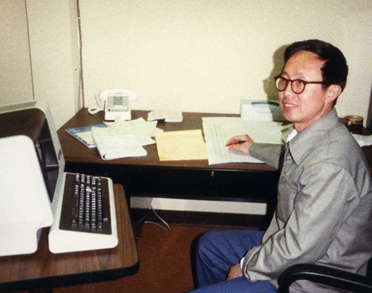
Xiong Guangze working at IMAG in Silicon Valley, USA
During his 9-to-5 job, Xiong Guangze seized every spare moment to learn and improve himself. He arrived early for classes at Stanford University for the Early Bird program for working professionals and attended evening classes at Santa Clara University. Without a private car, he took public transportation; time and distance never hindered his learning pace. His Chinese friends also offered him advice, and after purchasing a student outfit, Xiong Guangze quietly sat in the back row of the classroom, his eyes filled with a thirst for modern technological knowledge. The fatigue from work vanished after knowledge flowed into his brain; he absorbed all the materials he could get his hands on. He devoted all his spare time outside of work to learning because he understood that this was not only his personal need for knowledge but also the urgent need for his country’s scientific and technological development. To achieve catch-up development, we must put in more effort than developed countries.
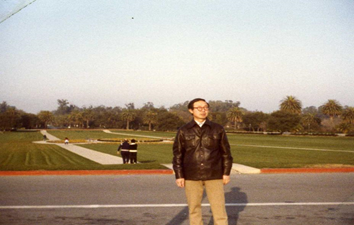
In Silicon Valley, it was difficult to see scholars from mainland China at that time, but Xiong Guangze still felt the kindness of local Chinese expatriates from Hong Kong, Macau, and Taiwan, which made him feel the shared bloodline of the Chinese nation and the common desire for a strong China. No matter when and where, the hearts of our entire nation are always connected. One Chinese restaurant owner provided significant help to Xiong Guangze; as a person in a foreign land, accommodation and food were always the first needs to solve. The owner suggested that Xiong Guangze share a rental with his nephew for just $200, allowing him to live in the heart of Silicon Valley, greatly saving on expenses and commuting time. The considerate owner also volunteered to waive Xiong’s meal fees and cook for him separately, but the frugal Xiong Guangze chose to dine with the restaurant staff. Although Xiong Guangze, as a UN-sponsored visiting scholar, received three times the stipend of regular sponsored students, he was unwilling to waste. He said, “This money is given by the United Nations to China, unrelated to personal identity!” He strictly set daily expense limits for himself, and all saved funds were used to purchase equipment and materials for the laboratory. Other expatriates also took good care of Xiong Guangze, taking him to gatherings and sightseeing on weekends, allowing him to experience American culture and helping him at work. Due to the USA’s clear technical restrictions on foreign visitors, his friends did everything possible to help Xiong Guangze gather various materials within legal limits. Furthermore, Xiong Guangze and Professor Liu Jinde used the savings from their UN scholarships to purchase a batch of books, devices, and tools, shipping about ten boxes back to China, providing strong support for future microcomputer technology application development upon their return.
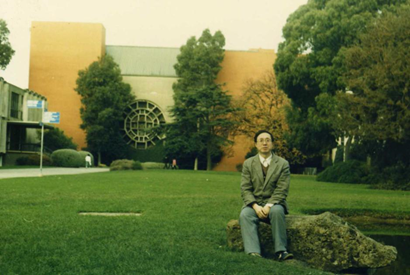
The second trip abroad to Melbourne, Australia, occurred when Xiong Guangze was in his forties. Among the foreign experts hired for UN projects, he discovered that Australian experts had a deep foundation in operating systems and hardware-software integration theory, which was worth tracking and studying in-depth. At the age of reason, Xiong Guangze had a great interest in operating systems, and based on his strong thirst for knowledge, he proposed to go to Australia for in-depth learning and exchange. Thus, he packed his bags again and set off for the other side of the ocean. Australia, with its abundant natural resources and world-renowned teachers with high salaries, provided Xiong Guangze with a rich research and learning atmosphere for studying operating systems and chip design. Due to its vast land and sparse population, universities in Australia placed great importance on the development of robotics. With his sharp thinking and clear mind, Xiong Guangze went to the CIT Polytechnic University in Melbourne, which is related to robotics. He explored the embedded operating system technology hidden within the core software of robots, finding relevant firmware and materials. After returning to China, based on this foundation, he led a graduate team with Luo Lei as the backbone to conduct research and application of embedded real-time operating systems in the country. By completing the “Eighth Five-Year Plan” science and technology project, combining theory with practice, they firmly grasped the key technologies of embedded real-time software in the hands of the country, making outstanding contributions to China’s scientific research endeavors.
“Having seen the vast world, I still cherish the green of the grass and trees,” Xiong Guangze said that his two experiences abroad had a profound impact on him. Whether it was the exceptionally active innovative thinking in Silicon Valley or the patriotism displayed by the flags flying in front of every household, he was deeply moved. A federal country with over two hundred years of history exhibits such patriotism, and the Chinese nation with five thousand years of history should unite as one. Innovation is the soul of a nation’s progress, while patriotism is the foundation upon which a nation survives. We are merely grains of sand in the era and should conform to the country’s situation, respond to the party’s call, and prioritize collective interests before developing ourselves. Professor Xiong humbly expressed, “I am well aware of the limitations of individual capabilities; without the platform of the country, I would not be able to witness the vastness of the world.”
During the late stage of the “Cultural Revolution,” digital computers gradually occupied the forefront of development. Following Professor Liu Jinde, Xiong Guangze decisively shifted his research focus from analog computers to digital computers. To master the relevant technologies more quickly, they started with lower-level microprocessors from abroad, dissecting chips layer by layer. The process was certainly arduous, but the research group finally took the first step in studying microcomputers, achieving groundbreaking progress. However, domestic technology was always limited, and researchers needed a broader platform. Xiong Guangze was selected to enter Silicon Valley, carrying the hopes of China’s technological development, just like many other researchers studying abroad.
While studying abroad, Xiong Guangze continuously absorbed knowledge from classes, exhibitions, and academic exchanges, further solidifying his research direction in microcomputers. He believed that to excel in microcomputer development and application, one must first have good debugging devices for hardware and software. As the saying goes, “To do a good job, one must first sharpen their tools,” and this tool is the in-circuit emulator. In 1983, Xiong Guangze returned to China, using his leftover living expenses to purchase materials, manuals, and components for developing the emulator. After returning, he devoted himself to research, and with persistent effort, he and a group of students led by Lu Wenbin developed the EMUL-85A online emulator, which was then successfully used in the research and development of secure communication equipment.
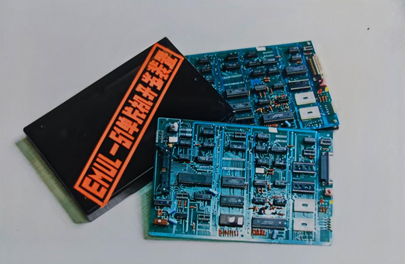
EMUL-51 microcontroller development device
During Xiong Guangze’s study abroad, domestic development tool research was also rapidly advancing, sparking a “single board computer craze,” with research focusing on embedded microprocessor single board computers as the mainstream. At this time, single board computers integrated tools and applications, simplifying debugging steps, but the application products made were large, power-hungry, and difficult to expand due to processor limitations on Z80. Professor Xiong Guangze’s research team developed online emulators supporting the direct embedding of microprocessors into application product circuit boards, overcoming the aforementioned shortcomings, and also providing hardware debugging capabilities for circuit logic analysis. Seizing this breakthrough, the team successively developed EMUL series products supporting multiple types of processors such as Z80, 8051, DSP, and accompanying cross-development software for PC, catching up with international technological development and greatly improving the efficiency of application product development, thus winning the Sichuan Province Science and Technology Progress Award.
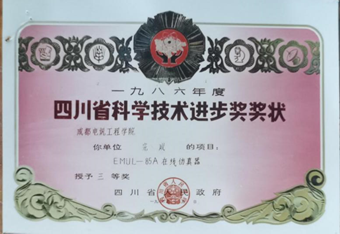
EMUL project won the Sichuan Province Science and Technology Progress Award
Scientific and technological progress knows no bounds, and innovative exploration cannot be slackened. In 1988, when Professor Xiong returned from Australia, the original development tool research team, relying on the foundation of the EMUL-51 microcontroller emulator, was busy developing and promoting electric furnace steel control devices. Professor Xiong did not rest on the laurels of existing emulator achievements; while wrapping up the microcomputer control project for the electric furnace at the Erzhong Factory, he tirelessly organized embedded real-time operating system technical materials and sought opportunities to engage in the upcoming “Ninth Five-Year Plan” national project.
Professor Xiong said that this was the most arduous period of his scientific research career. First, there was no national project funding support; second, the promotional expenses for tool-based achievements were high, and the returns were low, insufficient to support the preparation of new projects and the normal expenses of the team. For two years, the team’s staff salaries were covered by loans. With a pursuit of breakthroughs in embedded real-time operating system technology and an unwavering belief in victory, Xiong Guangze led the team to face difficulties head-on, persevering and brainstorming to overcome challenges, ultimately paving the way and welcoming the dawn.
First, team members were sent to Jiangnan to package and transfer the emulator technology achievements at a low price to an instrument company in Jiangsu, freeing them up to accomplish two things: one was to assign someone to contract the promotion of electric arc furnace controllers, and the other was for Professor Xiong to form and lead an operating system group to conduct preliminary research and strive for “Ninth Five-Year Plan” project approval. Hard work pays off; the students and Professor Xiong collaborated, and under his guidance, graduate Luo Lei repeatedly experimented on the UNIX computer system introduced by the United Nations, finally analyzing the design ideas for a certain embedded operating system firmware. Subsequently, he guided a group of graduate students to develop a prototype of operating system software on a target machine with a different instruction system based on a self-designed real-time scheduling algorithm. The breakthrough in key technologies boosted the team’s confidence in securing a project in the national plan. With the planning and encouragement of Professor Liu Jinde, Professor Xiong’s team finally obtained the national “Ninth Five-Year Plan” key pre-research project, receiving several hundred thousand yuan in research funding, officially launching related technological breakthroughs.
In the path of scientific research, countless times they opened roads in the mountains and built bridges in the water. Though this journey was not entirely smooth, it provided Xiong Guangze with invaluable experience. “Scientific research needs to be put into practice; practice brings true knowledge. The research results must be applied; only through practice can they be continually tested and improved. Only when users dare to use and like to use them can they be considered successful,” Professor Xiong said.
Xiong Guangze always believes, “To apply research results in practice is to transform them into the country’s economic strength.” Whenever he develops new results, he makes several units, places them in the UN training center, invites and guides users in their use, especially sending them to frontline users for trial use, collecting feedback, and then improving and innovating. His approach of integrating production, learning, and research has also received high praise from academician Zhu Guangya, a pioneer of the two bombs.
After the EMUL emulator results won the Technology Progress Award, Xiong Guangze realized that even equipping every laboratory in the school with such emulators was far from achieving the goal of results transformation. Considering the widespread demand for microcontroller emulation equipment from frontline enterprises and research departments in China, Xiong Guangze decided to find a factory to cooperate in producing microcontroller emulation development devices. They reached an agreement with a nearby company that produced power supply accessories for IBM/PC, where they would provide the technology, and the company would provide the production line, jointly producing microcontroller emulation devices named “Wildcat” microcontroller emulation development device, symbolizing its ability to catch mice and bugs (Debug). They prominently promoted it in the national microcontroller application technology annual meeting in Nanjing. Due to its strong functions, high quality, and catchy name, it quickly gained user favor and received a wave of orders. Subsequently, they held training sessions for users at the UNIDO training center at Chengdu University of Electronic Science and Technology, implementing multiple strategies, leading to an increase in orders. To save time, Xiong Guangze packaged the technology for transfer, freeing himself to focus on the critical technologies of real-time operating systems. With the joint efforts of the team and students, they developed a prototype of strong real-time embedded operating system software according to the indicators of the “Ninth Five-Year Plan” science and technology project. Following the tradition that team technological achievements must undergo frontline application practice testing, Professor Xiong, regardless of personal gain, voluntarily conducted practical applications in a key engineering project, successfully developing an airborne embedded real-time operating system, which eventually passed model engineering operation acceptance and received high user evaluation reports. The results of the “Ninth Five-Year Plan” technology breakthrough project undertaken by Professor Xiong also won the second prize for scientific and technological progress from the Ministry of Electronics Industry, greatly encouraging the team’s morale in transforming scientific research results into products.
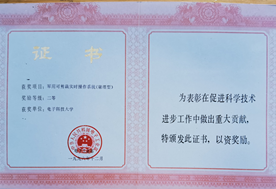
Professor Xiong Guangze’s real-time operating system won the second prize for scientific and technological progress from the Ministry of Electronics Industry
The successful application of this software was shared at a national academic annual meeting in a new specialized field, attracting attention from that field and investors. After being introduced by software distributors in that field, the Guangdong Nuclear Power Group expressed interest in investing in the product transformation of this software result. The Technology Park of Chengdu University of Electronic Science and Technology negotiated with them to establish a joint venture agreement to bring the results to market. At the first Shenzhen High-Tech Trading Fair, a formal contract was signed, with our university’s technology as a stake, and nuclear power invested 25 million yuan in capital to establish “Beijing Keyin Jingcheng Technology Co., Ltd.” Professor Xiong’s team and students immediately rented a venue nearby in the name of the university’s technology park to develop product transformation of the results, creating a lively atmosphere on-site. At this time, Luo Lei had already graduated and stayed at the university, becoming Professor Xiong’s capable assistant and a key teacher in the transformation development. After nearly a year of hard work, they developed a relatively complete application development support environment and functional modules centered on the operating system software results, officially opening in August 2000 at the headquarters of Keyin Company in Haidian, Beijing, and successfully held a product launch for the embedded software platform in Zhongguancun, naming the product “Dao System.” The platform product includes Delta OS Modules and Lanmda Tools. As of now, the company has released the sixth version—Dao System 6, successfully entering the product list of specialized fields in our country. While serving as the chief engineer at Keyin Company, Professor Xiong fully utilized the company’s R&D center located in Hongxing Bridge Tower to guide batches of graduate students in their research projects while also planning high-level academic research directions. Two years later, Professor Xiong resigned from the company to focus on guiding doctoral students in high-reliability real-time computing academic research and presiding over new five-year science and technology breakthrough projects, achieving gratifying results. Related research results won the National Defense Science and Technology Award in 2001.
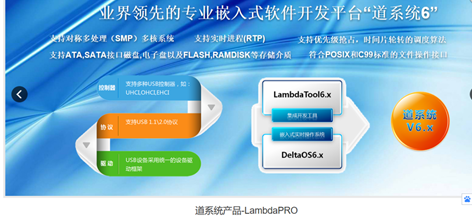
Keyin product display
The name “Beijing Keyin Jingcheng Technology Co., Ltd.” has become well-known. Professor Xiong initially thought he could return to the university to focus on in-depth theoretical research and train higher-level talents. Unexpectedly, Deputy Director Deng Nan of the National Science and Technology Commission visited the real-time computing research room at Chengdu University of Electronic Science and Technology to hear a report on the transformation of embedded software results, initiating research on the application of results in the manufacturing industry. Subsequently, the research room of Professor Xiong’s team was successively granted the titles of “Sichuan Province Key Laboratory” and “Ministry of Information Industry Key Laboratory.” The Guangdong Science and Technology Department also appointed Professor Xiong as an advisor to the Guangdong Software Park, conducting research in the Pearl River Delta to provide advice for the development of the manufacturing industry, and assisted the software park in creating a corporate shared resource base featuring the domestically produced “Dao System” brand embedded software platform. The process of investigating Guangdong’s private enterprises led Professor Xiong to emphasize the research direction of dedicated chip design technology and product reliability testing technology, expanding academic research directions for guiding doctoral studies in the future.
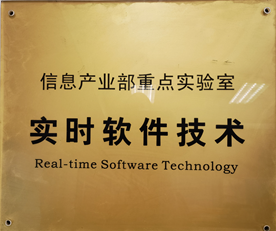
Ministry-level key laboratory
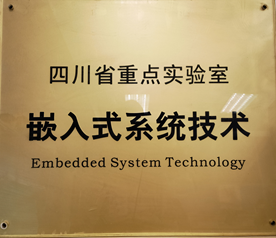
Provincial key laboratory
With the help of these laboratory platforms and the practice of scientific research and results transformation, Professor Xiong has diligently trained batches of high-level scientific and educational talents, including master’s, doctoral, and postdoctoral researchers. Seeing his students stepping into the job market and taking on responsibilities to contribute to society fills Professor Xiong with pride and happiness; he speaks of them as if recounting precious memories. The doctoral/postdoctoral students he has supervised, such as Guo Bing, who specializes in hardware-software integrated SOC, was appointed as a professor at Sichuan University and serves as the deputy dean of the College of Computer; Doctor Liao Yong, outstanding in education, is now the chief professor of core courses in software engineering at the School of Information and Software at our university and serves as the director of the teaching advisory committee, as well as a long-term lecturer on “Embedded Operating System Technology” at Renault Engineering School in France; female doctoral student Li Zhongwen is a professor at Xiamen University, undertaking cross-strait cooperation projects; Professor Luo Lei, doctoral supervisor, has joined the expert group of the 863 project, bringing glory to the university; many of his graduates have entered enterprises, military units, and engaged in software, vehicle control, aerospace, and weaponry research and development. Among them, there are entrepreneurs giving back to their alma mater, such as Du Xuan (chairman of Shenzhen Jinzhen, who donated to build the Qing Shui campus’s Xuan Bang building), Hua Xin (chairman of Maipu Company, who donated to build the gate of the Shahe campus), and Lu Wenbin (vice chairman of the alumni association of Chengdu University of Electronic Science and Technology, president of Creative Technology). Seeing their outstanding achievements in their respective fields fills Professor Xiong with a sense of pride, saying, “As a teacher, witnessing my students’ achievements is the greatest comfort.”
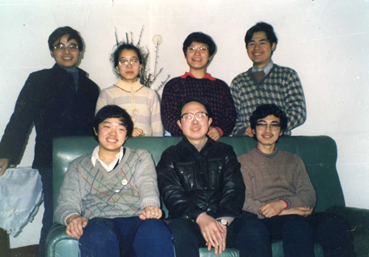
Research team and students from the Microcomputer Development Tools Research Room
When discussing his approach to talent cultivation, Professor Xiong has profound insights. Having worked as a guide for many years, he has his own views on cultivating scientific research talents. First, as a mentor, one must stand high enough to see the forefront of academia. Students’ insights are ultimately singular and limited, but mentors, who have been in this field for many years, should have keen thinking and the courage to explore the frontier. Secondly, it is necessary to provide students with a good learning and practice platform. The research room and laboratories established by Xiong Guangze have played a significant role in talent cultivation. He devoted the advanced technologies learned during his study abroad and the international-level software and development tools purchased into this endeavor. As a mentor, he is a selfless contributor, a guiding lighthouse, and a tireless spinning top. The rich academic atmosphere and abundant resources fully inspire students’ innovative and creative abilities. As the saying goes, “Teaching benefits both teachers and students.” In the collision of thoughts with students, Professor Xiong also produces more output and endless passion and motivation.
Professor Xiong Guangze speaks with excitement about his retirement life. He participates in various organizations, as if naturally endowed with leadership skills, often becoming the leader of the team due to his willingness to contribute and strong organizational abilities. He served as the president of the Old Professors Association and was also the leader of the choir, leading the old professors’ choir to participate in the Golden Age Choir Concert across the Taiwan Strait, expressing their infinite love for the motherland and the party through song. “I always feel that time is not enough.” Professor Xiong’s retirement life is fully arranged; he insists on practicing Tai Chi every day, mastering each move, and in his leisure time, he picks up books, with popular science articles broadening his thinking and social philosophy enlightening his understanding. Whatever he learns becomes part of his character. In this way, he achieves a balance of motion and stillness. Professor Xiong not only plays the erhu but has also self-taught the bawu. “Although my body is no longer as young as before, I still have a young heart.” Constantly learning and trying, he can emit infinite light within a limited time, illuminating public welfare and brightening the lives of everyone around him. He remains forever young, always filled with tears of joy and a positive attitude.
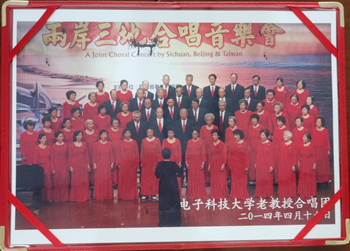
Group photo of the old professors’ choir
Looking back, Xiong Guangze has experienced many ups and downs: with a youthful heart for the world, he diligently studied and met good teachers at Chengdu University of Electronic Science and Technology; his study abroad journey was lonely and arduous, yet he was fortunate to receive help from overseas compatriots; he adjusted his research direction multiple times in scientific research, persevering for decades, ultimately achieving recognized results; he selflessly transformed results without regard for personal benefit, borrowing money to endure the toughest times, always concerned about national development; after retirement, he devoted himself to public welfare, learning and growing throughout his life, feeling fulfilled and happy. Professor Xiong summarizes his life with a seven-character quatrain: “In Li Tao’s hometown, striving hard, Yang Xiong’s talents shine bright. Gaining true knowledge across the ocean, adding ingenuity to the nation’s key instruments.”
Looking to the future, Xiong Guangze hopes that Chinese youth can aspire high and dedicate themselves to studying and working diligently, avoiding impatience. His experiences continuously inspire and urge us to forge ahead on the path of learning and contributing to the country. We thank Professor Xiong for the opportunity to interview him and wish him happiness and health in his later years!
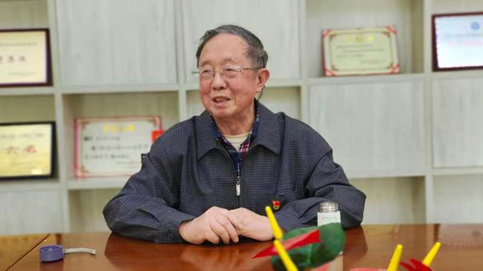
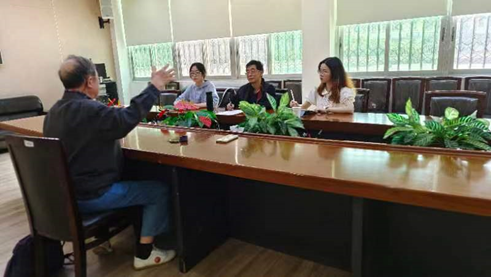
Text: Chengdu University of Electronic Science and Technology Studio Student Reporters Ou Keshan, Yu Yuru
Guided by: Chang Jiang
Edited by: Cheng Zihan, Zhang Xian
Reviewed by: Zhu Guoquan, Luo Dong